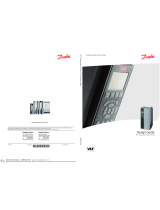
2 Introduction
2.1.1 About this Manual
First time users can obtain the most essential information for
quick installation and set-up in these chapters
Introduction
How to Install
How to Configure the System
For more detailed information including the full range of set-
up options and diagnosis tools please refer to the chapters:
How to Control the Frequency Converter
Parameters
Troubleshooting
2.1.2
Technical Overview
BACnet (Building Automation and Control Network) is an
open data communications protocol, American National
Standard (ANSI/ASHRAE 135-1995). BACnet provides a
means by which computer-based control equipment from
different manufacturers can work together. BACnet is
designed to handle many types of building controls,
including HVAC, lighting, security, fire, access control,
maintenance and waste management. BACnet permits
flexibility for expansion and different equipment
combinations.
Conformance Classes, Function Groups and the PICS:
Evaluating the capabilities of a BACnet device is potentially a
formidable task, given the great choice of Objects, Properties
and Services, which can be implemented, as well as the fact
that it is not necessary for every BACnet device to have a full
BACnet implementation in order to carry out its task.
ASHRAE's BACnet Committee recognized this problem and
responded with aids to evaluation in the form of
"Conformance Classes," "Function Groups" and the "Protocol
Implementation Conformance Statement" (PICS).
The BACnet protocol defines six levels of Conformance
Classes, each of which specifies the minimum subset of
Services implemented on the device. The lowest level,
Conformance Class 1, requires only that the BACnet device
contain a Device Object and that it be able to execute
(respond to) a ReadProperty Service request. Each successive
Conformance Class level adds Service Requests that must be
executable by the device, as well as the Service Requests it
must be able to initiate. Conformance Class 6 requires 21
types of Service Requests (of the 32 overall) to be
implemented, of which 20 must be initi able and 17
executable. Conformance Class thus provides a measure of
the device's ability to communicate.
Function Groups specify a combination of Objects and
Services necessary to carry out certain building automation
functions. They are specified independently of Conformance
Class, though the implementation of some of the Function
Groups automatically confers some Conformance Class
higher than 1.
Background information
Protocol name: BACnet
Technology developer: ASHRAE
Year introduced: 1995
Governing standards: ANSI/ASHRAE Standard
135-2008 version 4, ISO 16484-5
Openness: Open specification
Physical characteristics
Network topology: Bus
Physical media: Shielded twisted pair
Max. Distance at low speed: 1200 meters
Transport mechanism
Communication methods: Master/slave
Baud Rates Supported: 9600, 19200, 38400, 76800
Termination: 120 ohm
2.1.3 Assumptions
This manual assumes you are using the BACnet Protocol with
a FC102 series frequency converter. It is also assumed that
your system is equipped with a firmware supporting the
BACnet communication services required by your
application and that all requirements stipulated in the
BACnet standard, as well as those pertaining to the VLT
Variable Speed Drive are strictly observed as well as all
limitations therein fully respected.
2.1.4
Background Knowledge
The Danfoss BACnet Protocol is designed to communicate
with any system complying with the BACnet MS/TP standard.
Familiarity with the PC, BMS or PLC used as a master in the
system is assumed. Issues regarding hardware or software
produced by other manufacturers are beyond the scope of
this manual and are not the responsibility of Danfoss.
If you have questions regarding set-up of master-to-master
communication or communication to a non-Danfoss slave,
please consult the appropriate manuals.
Introduction
VLT
®
HVAC Drive Native BACnet Operating Instructions
MG.14.C1.02 - VLT
®
is a registered Danfoss trademark 5
2 2





















